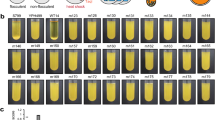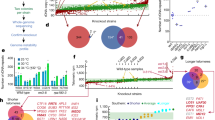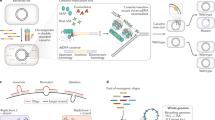Abstract
The structural and functional analysis of mammalian genomes would benefit from the ability to isolate from multiple DNA samples any targeted chromosomal segment that is the size of an average human gene. A cloning technique that is based on transformation-associated recombination (TAR) in the yeast Saccharomyces cerevisiae satisfies this need. It is a unique tool to selectively recover chromosome segments that are up to 250 kb in length from complex genomes. In addition, TAR cloning can be used to characterize gene function and genome variation, including polymorphic structural rearrangements, mutations and the evolution of gene families, and for long-range haplotyping.
This is a preview of subscription content, access via your institution
Access options
Subscribe to this journal
Receive 12 print issues and online access
$189.00 per year
only $15.75 per issue
Buy this article
- Purchase on Springer Link
- Instant access to full article PDF
Prices may be subject to local taxes which are calculated during checkout




Similar content being viewed by others
References
Larionov, V., Kouprina, N., Solomon, G., Barrett, J. C. & Resnick, M. A. Direct isolation of human BRCA2 gene by transformation-associated recombination in yeast. Proc. Natl Acad. Sci. USA 94, 7384–7387 (1997).
Kouprina, N. et al. Functional copies of a human gene can be directly isolated by TAR cloning with a small 3′ end target sequence. Proc. Natl Acad. Sci. USA 95, 4469–4474 (1998).
Ketner, G., Spencer, F., Tugendreich, S., Connelly, C. & Hieter, P. Efficient manipulation of the human adenovirus genome as an infectious yeast artificial chromosome clone. Proc. Natl Acad. Sci. USA 91, 6186–6190 (1994).
Larionov, V. et al. Specific cloning of human DNA as yeast artificial chromosomes by transformation-associated recombination. Proc. Natl Acad. Sci. USA 93, 491–496 (1996).
Bhargava, J. et al. Direct cloning of genomic DNA by recombinogenic targeting method using a yeast-bacterial shuttle vector, pClasper. Genomics 62, 285–288 (1999).
Burke, D. T., Carle, G. F. & Olson, M. V. Cloning of large segments of DNA into yeast by means of artificial chromosome vectors. Science 236, 806–812 (1987).
Noskov, V. et al. Defining the minimal length of sequence homology required for selective gene isolation by TAR cloning. Nucleic Acids Res. 29, e62 (2001).
Leem, S. H. et al. Optimum conditions for selective isolation of genes from complex genomes by transformation-associated recombination cloning. Nucleic Acids Res. 31, e29 (2003).
Leem, S. H. et al. Closing the gaps on human chromosome 19 revealed genes with a high density of repetitive tandemly arrayed elements. Genome Res. 14, 239–246 (2004).
Stinchomb, D. T., Thomas, M., Kelly, I., Selker, E. & Davis, R. W. Eukaryotic DNA segments capable of autonomous replication in yeast. Proc. Natl Acad. Sci. USA 77, 4559–4563 (1980).
Noskov, V. et al. A novel genetic system allowing to directly select gene-positive clones during the gene capture by transformation-associated recombination in yeast. Nucleic Acids Res. 30, e8 (2002).
Raymond, C. K. et al. Genetic variation at the O-antigen biosynthetic locus in Pseudomonas aeruginosa. J. Bacteriol. 184, 3614–3622 (2002).
Noskov, V. N. et al. A general transformation-associated recombination cloning system to selectively isolate any eukaryotic or prokaryotic genomic region. BMC Genomics, 4, 16–23 (2003).
Kouprina, N. & Larionov, V. in Current Protocols in Human Genetics (ed. Boyle, A. L.) (John Wiley & Sons, New York, 2000).
Kouprina, N., Noskov, V. N., Koriabine, M., Leem, S. H. & Larionov, V. Exploring transformation-associated recombination cloning for selective isolation of genomic regions. Methods Mol. Biol. 255, 69–90 (2004).
Shizuya, H. et al. Cloning and stable maintenance of 300-kilobase-pair fragments of human DNA in Escherichia coli using an F-factor-based vector. Proc. Natl Acad. Sci. USA 89, 8794–8797 (1992).
Ioannou, P. A. et al. A new bacteriophage P1-derived vector for the propagation of large human DNA fragments. Nature Genet. 6, 84–89 (1994).
Raymond, C. K. et al. Targeted, haplotype-resolved resequencing of long segments of the human genome. Genomics 86, 759–766 (2005).
Annab, L. et al. Isolation of a functional copy of the human BRCA1 gene by TAR cloning in yeast. Gene 250, 201–208 (2000).
Kouprina, N. et al. Segments missing from the draft human genome sequence can be isolated by TAR cloning in yeast. EMBO Rep. 4, 257–262 (2003).
Nihei, N. et al. Functional evidence for a metastasis suppressor gene for rat prostate cancer within a 60 kb region on human chromosome 8p21–p12. Cancer Res. 62, 367–370 (2002).
Leem, S. H. et al. Cloning of the human telomerase gene: complete genomic sequence and analysis of tandem repeats polymorphisms in intronic regions. Oncogene 21, 769–777 (2002).
Kouprina, N. et al. Dynamic structure of the SPANX gene cluster mapped to the prostate cancer susceptibility locus HPCX at Xq27. Genome Res. 15, 1477–1486 (2005).
Horikawa, I. et al. Differential cis-regulation of human versus mouse TERT gene expression in vivo: identification of a human-specific repression element. Proc. Natl Acad, Sci. USA 102, 18437–18442 (2005).
Ayabe, F. et al. A novel expression system for genomic DNA loci using a human artificial chromosome vector with transformation-associated recombination cloning. J. Hum. Genet. 50, 592–599 (2005).
Noskov, V. N. et al. A novel strategy for analysis of gene homologs and segmental genome duplications. J. Mol. Evol. 56, 702–710 (2003).
Pavlicek, A. et al. Evolution of the tumor suppressor BRCA1 locus in primates: implications for cancer predisposition. Hum. Mol. Genet. 13, 2737–2751 (2004).
Kouprina, N. et al. Accelerated evolution of the ASPM gene controlling brain size begins prior to human brain expansion. PLoS Biol. 2, 653–663 (2004).
Kouprina, N. et al. The SPANX gene family of cancer-testis specific antigens: rapid evolution, an unusual case of positive selection and amplification in African great apes and hominids. Proc. Natl Acad. Sci. USA 101, 3077–3082 (2004).
Kouprina, N. et al. The microcephaly ASPM gene is expressed in proliferating tissues and encodes for a mitotic spindle protein. Hum. Mol. Genet. 14, 2155–2165 (2005).
Salem, R. M., Wessel, J. & Schork, N. J. A comprehensive literature review of haplotyping software and methods for use with unrelated individuals. Hum. Genomics 2, 39–66 (2005).
International HapMap Consortium. A haplotype map of the human genome. Nature 437, 1299–1320 (2005).
Kim, J. H., Leem, S. H., Sunwoo, Y. & Kouprina, N. Separation of long-range human TERT gene haplotypes by transformation-associated recombination cloning in yeast. Oncogene 22, 2443–2456 (2003).
Westbrook, V. A. et al. Genomic organization, incidence, and localization of the SPANX family of cancer-testis antigens in melanoma tumors and cell lines. Clin. Cancer Res. 10, 101–112 (2004).
Baffoe-Bonnie, A. B. et al. A major locus for hereditary prostate cancer in Finland: localization by linkage disequilibrium of a haplotype in the HPCX region. Hum. Genet. 117, 307–316 (2005).
Sharp, A. J. et al. Segmental duplications and copy-number variation in the human genome. Am. J. Hum. Genet. 77, 78–88 (2005).
Shaw, C. J. & Lupski, J. R. Implications of human genome architecture for rearrangement-based disorders: the genomic basis of disease. Hum. Mol. Genet. 13, R57–R64 (2004).
Lockwood, W. W., Chari, R., Chi, B. & Lam, W. L. Recent advances in array comparative genomic hybridization technologies and their applications in human genetics. Eur. J. Hum. Genet. 1, 139–148 (2005).
Perry, G. H. et al. Hotspots for copy number variation in chimpanzees and humans. Proc. Natl Acad. Sci. USA 103, 8006–8011 (2006).
Feuk, L., Marshall, C. R., Wintle, R. F. & Scherer, S. W. Structural variants: changing the landscape of chromosomes and design of disease studies. Hum. Mol. Genet. 15, R57–R66 (2006).
Eichler, E. E., Clark, R. A. & She, X. An assessment of the sequence gaps: unfinished business in a finished human genome. Nature Rev. Genet. 5, 345–354 (2004).
Grimwood, J. et. al. The DNA sequence and biology of human chromosome 19. Nature, 428, 529–535 (2004).
Grimes, B. R. & Monaco, Z. L. Artificial and engineered chromosomes: developments and prospects for gene therapy. Chromosoma 114, 230–241 (2005).
Basu, J. & Willard, H. F. Artificial and engineered chromosomes: non-integrating vectors for gene therapy. Trends Mol. Med. 11, 251–258 (2005).
Ikeno, M. et al. Generation of human artificial chromosomes expressing naturally controlled guanosine triphosphate cyclohydrolase I gene. Genes Cells 10, 1021–1032 (2002).
Mejia, J. E. et al. Efficiency of de novo centromere formation in human artificial chromosomes. Genomics 79, 297–304 (2002).
Kotzamanis, G. et al. Construction of human artificial chromosome vectors by recombineering. Gene 351, 29–38 (2005).
Kakeda, M. et al. Human artificial chromosome (HAC) vector provides long-term therapeutic transgene expression in normal human primary fibroblasts. Gene Ther. 12, 852–856 (2005).
Grimes, B. R., Rhoades, A. A. & Willard, H. F. α-Satellite DNA and vector composition influence rates of human artificial chromosome formation. Mol. Ther. 5, 798–805 (2002).
Basu, J., Compitello, G., Stromberg, G., Willard, H. F. & Van Bokkelen, G. Efficient assembly of de novo human artificial chromosomes from large genomic loci. BMC Biotechnol. 5, 21 (2005).
Kouprina, N. et al. Cloning of human centromeres by transformation-associated recombination in yeast and generation of functional human artificial chromosomes. Nucleic Acids Res. 31, 922–934 (2003).
Ebersole, T. et al. Rapid generation of long synthetic tandem repeats and its application for analysis in human artificial chromosome formation. Nucleic Acids Res. 33, e130 (2005).
Becker, M. et al. Isolation of the repertoire of VSG expression site containing telomeres of Trypanosoma brucei 427 using transformation-associated recombination in yeast. Genome Res. 14, 2319–2329 (2004).
Author information
Authors and Affiliations
Corresponding author
Ethics declarations
Competing interests
The authors declare no competing financial interests.
Related links
Glossary
- Alphoid DNA
-
A 170 bp AT-rich repeat that is present in the centromeric regions of all human chromosomes. The repeat forms large tandem arrays with sizes of up to 5 Mb.
- Alu interspersed
-
A ∼300 bp repeat that is specific to primates. There are approximately 1.5 million copies of this repeat in the human genome.
- ARS
-
Autonomously replicating sequence — a small DNA fragment that can support replication in the budding yeast.
- Comparative genomic hybridization
-
A technology through which tumour and reference DNA are differentially labelled to show copy-number changes in tumour genomes.
- Contig
-
From contiguous. A set of clones that represent a continuous region of DNA. A contig map depicts the relative order of a linked library of contigs that represent a complete chromosome segment.
- HAC
-
Human artificial chromosome — a system for cloning large DNA segments in mammalian cells. Similar to natural chromosomes, HACs have a functional centromere and therefore are stably maintained in a single copy during mitotic cell divisions.
- Kinetochore
-
The protein structure in eukaryotes that assembles on the centromere and links the chromosome to microtubule polymers from the mitotic spindle during mitosis.
- Minisatellites
-
A class of repetitive sequences, each of which is 7–100 nucleotides, that span 500–20,000 bp and are mainly located towards chromosome ends.
- Segmental duplications
-
Large genomic segments of recent origin and nearly identical sequence.
- Spermatocyte
-
A male gametocyte that is derived from a spermatogonium. Initially, a spermatogonium divides by mitosis into two 'primary spermatocytes'. A primary spermatocyte is diploid and, by meiosis, gives place to two secondary spermatocytes, which are haploid.
- Synteny
-
Collinearity in the order of genes (or of other DNA sequences) in a chromosomal region of two species.
- Yeast spheroplasts
-
Yeast cells following the removal of the cell wall. They can take up large DNA molecules (up to 1 Mb), and were used to construct the first genomic YAC libraries.
- Z-DNA
-
A form of DNA in which the double helix winds to the left in a zig-zag pattern (instead of to the right, like the more common B-DNA form).
Rights and permissions
About this article
Cite this article
Kouprina, N., Larionov, V. TAR cloning: insights into gene function, long-range haplotypes and genome structure and evolution. Nat Rev Genet 7, 805–812 (2006). https://doi.org/10.1038/nrg1943
Issue Date:
DOI: https://doi.org/10.1038/nrg1943
This article is cited by
-
Serine protease PRSS56, a novel cancer-testis antigen activated by DNA hypomethylation, promotes colorectal and gastric cancer progression via PI3K/AKT axis
Cell & Bioscience (2023)
-
Continuous synthesis of E. coli genome sections and Mb-scale human DNA assembly
Nature (2023)
-
Bifurcation drives the evolution of assembly-line biosynthesis
Nature Communications (2022)
-
Saccharomyces cerevisiae as host for the recombinant production of polyketides and nonribosomal peptides
Microbial Cell Factories (2021)
-
The genomic structure of a human chromosome 22 nucleolar organizer region determined by TAR cloning
Scientific Reports (2021)



